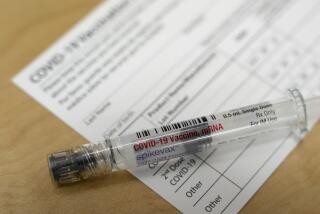Public Access to Smallpox Vaccine Is Urged
- Share via
WASHINGTON — After as many as 10 million health care workers and emergency personnel are immunized against smallpox, a licensed vaccine should be made available to all Americans who want it, the government’s top public health officials said Friday.
But the officials said their position did not necessarily reflect the Bush administration’s view on who should be protected against a possible terrorist attack using smallpox.
They stressed repeatedly that President Bush had not made a decision.
“We represent the public health perspective, but the decision also has to be made on the grounds of homeland security and national security,” said Dr. Julie Gerberding, director of the federal Centers for Disease Control and Prevention in Atlanta.
The United States stopped routinely vaccinating children against smallpox in 1972, and the disease was eradicated worldwide in 1980. But last year’s terrorist attacks raised fears that the highly contagious virus, which kills almost a third of those infected, could be used as a biological weapon.
Since then, the administration has dramatically increased the nation’s vaccine supply.
It determined that old stocks could be watered down and it contracted with manufacturers for the fast-track production of millions of additional doses. Federal health agencies also are working with state and local governments to develop mass-immunization plans, and officials said Friday there is enough vaccine for all Americans.
States should be able to vaccinate as many as 1 million people in the first 10 days after a smallpox attack, the CDC said last month.
What makes the pre-attack inoculation decision so difficult are the risks associated with the vaccine. Using vaccination data from the 1960s, scientists estimate that for every million people vaccinated, the live virus will replicate in 900, causing complications such as rash, fever and body aches. About 15 people would develop encephalitis or other life-threatening conditions, and one or two of those individuals would die.
The risks of the vaccine to the current American population could be even greater--or smaller. On the one hand, the rate of complications is lower for people who were vaccinated as children. On the other, the vaccine poses serious risks for individuals with weakened immune systems--HIV, cancer and transplant patients, for example--and those with eczema and other skin disorders.
That at-risk population could number more than 30 million, said Dr. Anthony Fauci, director of the National Institute of Allergy and Infectious Diseases. Highlighting some of the complicating factors associated with the disease--the virus can be transmitted from a vaccine site to another individual, for example--Fauci said people living with individuals who have weakened immune systems should not get the vaccine.
“We stopped using this vaccine when the disease was eradicated because it’s dangerous,” Gerberding said. “So it’s not a straightforward” decision to use the vaccine now just because it’s available, she said.
Nevertheless, after weighing the “tension between wanting to be safe, the lack of ability to predict the threat and the recognition that people are afraid,” top scientists at the CDC, the National Institutes of Health and the Health and Human Services Department concluded that the government should “let people make up their own mind,” Gerberding said.
“We live in a society that values individual choice.”
Even if President Bush decides to make the vaccine available to everyone, most Americans would not have access to it until early 2004, after new supplies have been licensed by the U.S. Food and Drug Administration.
“None of us believe we should make it available to the general public right now,” said Jerry Hauer, assistant Health and Human Services secretary for emergency health preparedness.
But some vaccine supplies could be licensed as early as next month, and health officials favor getting front-line health care and emergency workers immunized as soon as possible after the vaccination policy is announced.
The phased approach they favor could make the vaccine available first to about 500,000 front-line health care workers--the public health teams who would investigate smallpox cases and the doctors, nurses and support personnel in hospital emergency rooms who would probably be the first to treat infected pa- tients.
Next, the vaccine would be offered to all of the nation’s 7 million health care workers and about 3 million police, fire and other emergency workers, Hauer said.
An earlier recommendation proposed designating one or two “smallpox” hospitals in each city. Health care officials have now rejected that idea, in part because hospitals resisted it so strongly. They also realized such a plan was not realistic, Hauer said.
“When people have rash and a fever, they’re going to go to the nearest ER, not a smallpox-designated hospital,” he said.
Officials said Friday they decided to take the unusual step of briefing reporters before the pre-event policy was announced because the issues were complex and the potential for confusion and panic so high.
“I, for one, am not worried,” Gerberding said. “I think ultimately we’ll get to the right decision.”
More to Read
Sign up for Essential California
The most important California stories and recommendations in your inbox every morning.
You may occasionally receive promotional content from the Los Angeles Times.













